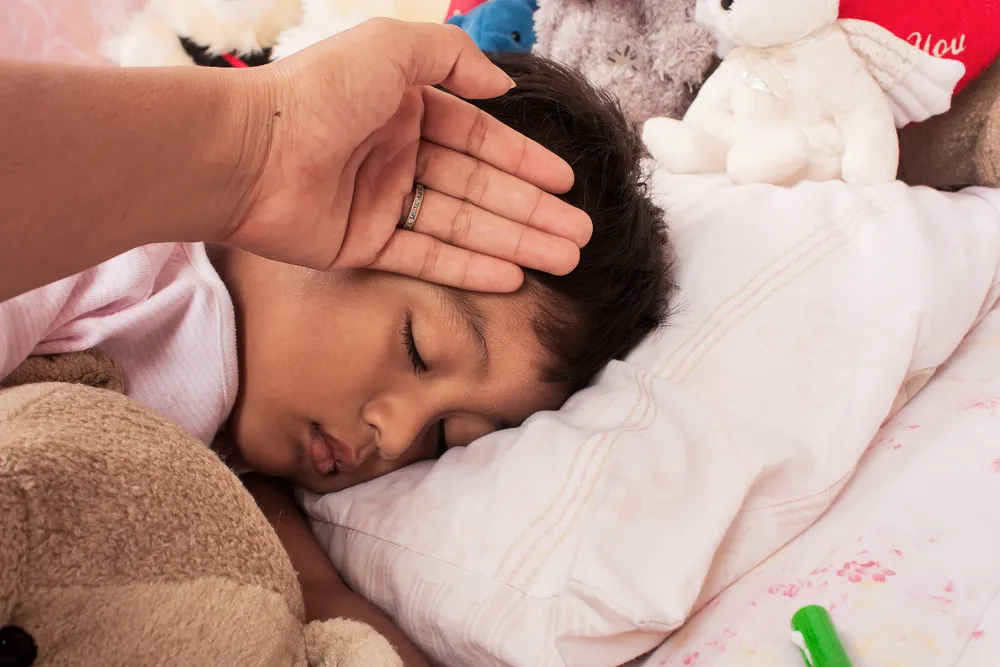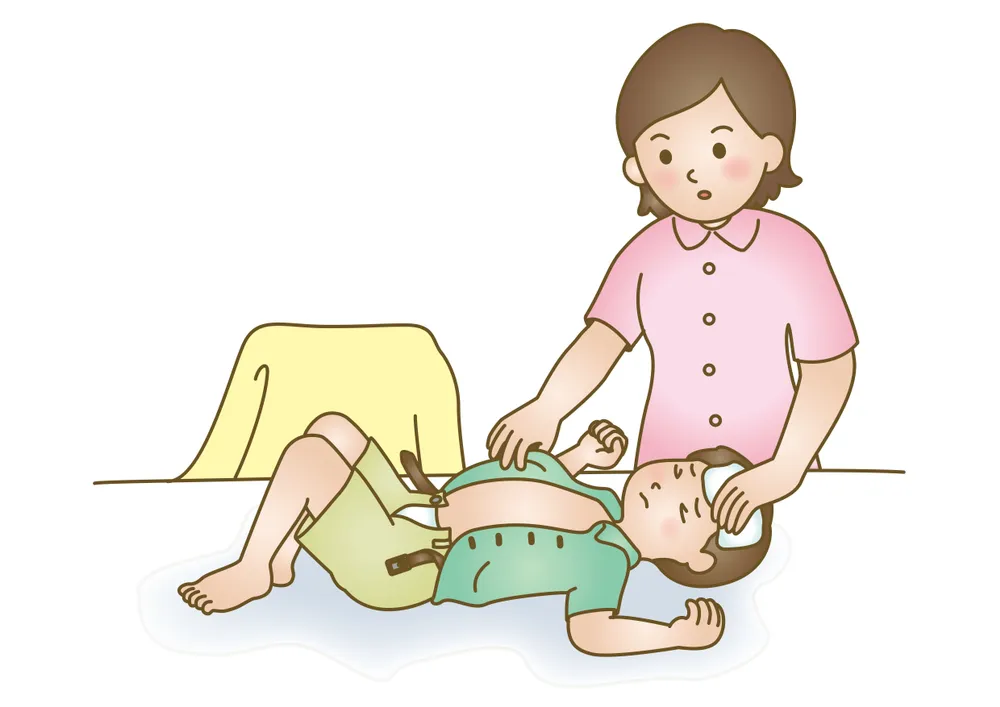The flu season typically runs from October to April (and even until May some years). This season is especially active, and the virus also doesn’t have a preference for how old its host is – and that includes kids. This is why flu vaccination schedules should be followed for all ages.
While flu symptoms in children closely mimic those of adults, sometimes a child can’t verbalize their symptoms as well. That leaves it up to parents and healthcare professionals to examine the evidence to determine if it’s influenza, and whether treatment is required. Here are 12 signs to look for…
1. An Unusually High Temperature
Here’s something key about the flu in kids – they might register a higher temperature than an adult with the virus, which could lead to panic in some situations. Children can run temperatures up to 104-Fahrenheit or more without the flu (it’s not dangerous to the brain until it hits 108-Fahrenheit), and in some cases, an infection may not cause a fever.
The Seattle Children’s Hospital notes that while a temperature combined with other symptoms indicate a fever in most cases, it adds that children may also be warm from activity or crying too hard. Take your child’s temperature again in about 20-minutes after a high reading (above 99.5-Fahrenheit) to determine if they’re actually running a fever or just temporary overheated.
2. Increased Crying or Fussing
If your infant or toddler is normally pretty chilled out, and won’t stop crying when you try the regular things like feeding and napping, then you might want to take their temperature. Keep in mind as we already mentioned, a higher than normal reading doesn’t mean it’s a fever, which is a telltale sign of the flu.
However, if your child is restless and upset and has one or more of the other symptoms that we’ll be telling you about, then you might want to keep influenza as a possible suspect. There are many reasons your baby may be crying more often than normal, according to BabyCentre UK, but it advises to contact a physician if they’re under 3-months old and their temperature is above 38C (100.4-Fahrenheit).
3. Vomiting and Diarrhea
Flu symptoms can make patients of all ages feel like they need to run to the bathroom quickly, but this is even more common among kids – especially younger ones that might not recognize the cue to visit the toilet.
If your child is throwing up a lot, there’s also a chance it might be stomach flu (medically known as gastroenteritis) – it’s not the same as influenza virus, which oftentimes doesn’t affect the stomach, says WebMD. In any case, you’ll want to make sure your child stays hydrated, and to consult a medical professional if vomiting or diarrhea persists.
4. Shivering and Chills
If your little one seems to be shaking a bit but it’s 72-Fahrenheit inside your home, then this could be a red flag that flu is at work. EveryDay Health explains that chills often accompany a fever – this is because the brain raises the body’s “thermostat” to help fight off an infection, and the shivers are your body’s reaction to reach that higher internal temperature.
Shivering can also be a symptom of a low body temperature, which is not considered dangerous on its own. However, shaking not associated with flu could be a sign of another injection that can be dangerous for children and the elderly. Check your child’s temperature to rule this factor out.
5. Loss of Appetite
This can be one of the most obvious flu clues, especially in children too young to complain or who are non-verbal. It might mean your infant doesn’t take to breastfeeding, or seems to get full faster with formula. However, there are 2-dangers with this symptom, especially in younger kids.
One is that they can become dehydrated quickly, which can be dangerous and even fatal, says Medical News Today. At the same time, a fever associated with flu can burn through fluid reserves in the body more rapidly from sweating and other factors. Depending on age, you can offer sips of water, popsicles, smoothies, or easily chewed fruit such as melons to keep hydration at safe levels and deliver some vitamins.
6. Sore Throat
Having a sore throat might be another contributing factor to why your child doesn’t want to eat – at least solid foods, anyway. Again, sore throat is another flu symptom that a young child might not be able to communicate, and could require a doctor to examine for inflammation or infection.
However, not all sore throats mean a child has the flu. It can also be the result of a common cold, or the dreaded strep throat that may be treated with antibiotics. There are also potentially more serious reasons for a sore throat in older children, including tonsillitis, so if your child is complaining of sore throat that isn’t going away then it’s best not to ignore it.
7. Sudden Onset
If your child seems fine one day and not the next, then you’re probably dealing with the flu and not just the common cold, notes Kids Health. Rapid onset of symptoms is one of the telltale signs of influenza in children, along with fever and chills that a cold doesn’t typically cause.
The symptoms can develop within 48-hours of being exposed to the virus, and your child may be contagious to others for a day before they start showing any signs of infection (and for up to seven days or more after symptoms arise), notes eMedicineHealth.com.
8. Febrile Seizures
Anything with the word “seizure” in it can cause alarm for parents. But the reality is that a spike in temperature, like one from a flu-related fever, can cause full-body convulsions known as febrile seizures. They usually strike in kids aged 6-months to 5-years who have a temperature of 100.4-Fahrenheit or higher, says Medicine Plus.
The good news is, says the source, is that while these seizures can be concerning, they’re not usually harmful and don’t often indicate a serious underlying problem. They can also coincide with a cold or another viral infection, and typically occur in the first day of an illness (and not always when a temperature is at its highest point), it adds.
9. Earaches
Ear pain is a common occurrence among younger children, and it could be an indication of an ear infection. This is caused by inflammation, caused by bacteria leading to excess fluid behind the eardrum. According to the National Institute on Deafness and Other Communication Disorders, more than 80-percent of children will suffer an ear infection by age 3.
The Mayo Clinic says the infection is often caused by flu or cold that leads to congestion and swelling of the Eustachian tubes, which connect the middle ear to the back of the throat. If these tubes are blocked, it can lead to fluid buildup that becomes prone to infection, adds the source.
10. Coughing
Kids cough often, that’s no secret. It may not be reason for alarm at first. However, excessive coughing is a possible sign of the flu. A cough caused by the flu will have a dry-sounding quality, says Caring For Kids. It also explains that while the other symptoms of flu can clear up, a nagging cough can linger for up to 2-weeks following.
In younger children, the cough might sound like barking, otherwise known as “croup”) and even lead to pneumonia, a potentially dangerous lung infection. Viral pneumonia isn’t treated with antibiotics like bacterial pneumonia is, so the usual course of treatment involves rest, plenty of fluids, and in some cases antiviral drugs. Coughing is also one of the primary ways that the virus is spread from child to child, explains Caring For Kids.
11. Runny Nose
A drippy nose in a child can be caused by anything that irritates the nasal tissues, and the flu is one of those possible causes. VeryWell Mind says that a viral upper respiratory tract infection (such as influenza) can cause normally clear mucus to turn thicker and yellow or green.
Parents often mistake the runny nose for an allergy, when it’s in fact a viral infection, notes the source. But a runny nose could also be the result of hay fever or other allergies, which can also be marked by dark circles under the eyes, adds the source. It can also be a sign of a deviated septum in the nose, nasal polyps, or irritants in the home such as smoke and certain odors, it adds.
12. Lethargy
If your usually bouncy bundle of joy doesn’t seem that interested in playing, is moving slowly, or has a weaker grasp than usual, it could be blamed on the flu. Healthline says lethargy and trouble waking your child from their slumber are reasons to be concerned, and that you should seek immediate medical attention.
Aside from fatigue and lack of energy, lethargic symptoms can also include mood changes, decreased alertness, and foggy thinking (which may be more obvious in older kids). People that are lethargic for whatever reason “may act as if they’re in a daze,” says Healthline.















